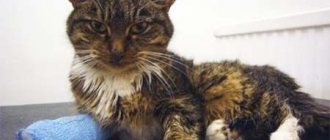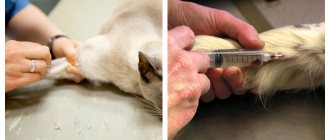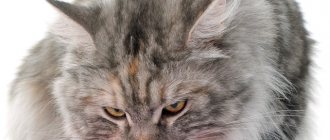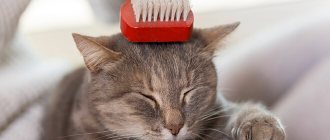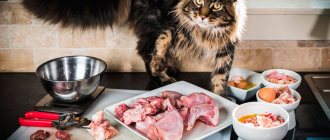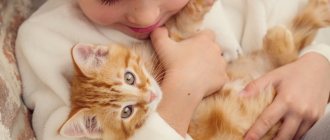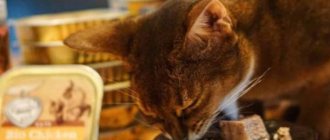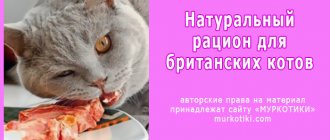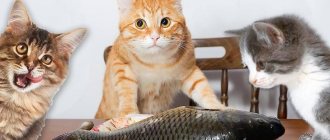Many families have pets. These cute animals lift spirits; caring for them teaches children to work and responsibility, and in some cases can alleviate loneliness. This is why many people love cats, dogs, parrots, canaries, aquarium fish and other “living creatures”. But it’s one thing to love, and another to properly care for animals. For example, cats live in many families, but not everyone takes good care of them. Every little detail is important in this matter, especially proper nutrition. What should cats be fed, what advice do veterinarians give on this matter? Let's figure it out.
Using special cat food
All pets, including felines, need proper and balanced nutrition.
Many veterinarians recommend using food that is specifically made for cats .
The positive aspects of this feeding method include the following:
- practicality;
- convenience;
- efficiency.
It is the last argument that often becomes decisive. The fact is that if you purchase all the ingredients contained in a ready-made mixture for feeding cats separately, it will not be cheap.
Practicality and ease of use are also important advantages. Owners just need to open a pack or canned food with ready-made food and put the contents in a bowl. There is no need to waste time and effort preparing food. Fill the bowl and go about your business.
Advantages of ready-made formulas for feeding cats
Another important advantage of the ready-made mixture that can be fed to cats is its balance.
This food is prepared based on the recommendations and research of veterinarians. This means that it already contains all the necessary nutrients , microelements and vitamins. In addition, mixtures are produced that can be fed to kittens or adults. After all, at every age an animal needs its own diet.
But this method of feeding your pet also has some disadvantages. First of all, it is worth mentioning the wide range of cat food.
On the one hand, having a choice is good, but on the other hand, it is an opportunity to make the wrong choice . Very often, manufacturers spend more money on advertising their products rather than on their quality.
Many veterinarians have some concerns about the food that is produced in our country. Quite often, expensive ingredients are replaced with cheap ones.
For example, the packaging may say that the dry mixture contains meat, but in fact, ground bones, tendons or other “waste” from meat production are added to it. Therefore, you should be careful when choosing the mixtures that you will feed your cat.
In addition, some cats may be allergic to ready-made food mixtures. In this case, you can either try different options (and your pet will suffer) or feed the animal natural food.
From prescription diets to a healthy diet
More patients were taking prescription medications or eating prescription food. This was supposed to help cope with the diseases that Andrea saw daily in her practice:
- persistent problems with the bladder and urinary system,
- obesity,
- diabetes,
- chronic nausea and/or diarrhea,
- chronic constipation,
- asthma,
- skin and ear problems, to name a few.
To help sick cats, Andrea prescribed many medications, but encountered side effects and complications from taking the drugs. In other cases, the medications simply stopped working after a while. Prescription food was no more beneficial: cats often refused it. Those animals that ate it did not experience any changes for the better.
One day, one of the veterinarian’s clients told her that she had switched her cat Max to raw food. After a few weeks, the woman noticed that the cat’s chronic skin and ear problems had disappeared. Before this, poor Max had to take cortisone-based medications and eat prescription food (prescribed by Andrea) for years, but there was no progress. After this story, Andrea decided to study in detail the issue of feeding cats.
Andrea studied the literature and spoke with veterinarians and owners who fed raw food to their pets. After this, she decided to switch her cat Bug to a raw diet. When Bug was picked up, he was six months old, emaciated, and his life was in serious danger. After Bug switched to a natural diet, he blossomed right before his owner’s eyes:
- gained muscle mass, but did not get fat,
- got beautiful fur,
- many of his chronic illnesses went away on their own, without taking medications.
Andrea is sure that the reason for Bug’s healing was the switch to raw food.
Which ready-made food is best to use?
Today you can find several varieties of ready-made cat food on sale. The store shelves display canned food, wet and dry food .
Is this or that variety better or worse? Cats consider canned food to be a treat. Canned food includes natural meat, vegetables and other ingredients that are both healthy and tasty.
When purchasing such food, you will be able to evaluate the quality of the products used, because everything can be seen by simply opening the can. The disadvantage of this food is its high cost.
Wet food comes in sealed packs. It includes pieces of meat or fish drenched in sauce. This food is cheaper than canned food, so it does not always use high-quality products.
Many cat owners consider the dry variety of food to be the most practical . This food is stored for a long time, cats like it and does not spoil after being in a bowl for a long time (it will not dry out and midges will not appear in the room).
But here it is worth considering one fact. When buying dry food, you cannot be sure of the quality of the products used in its preparation. Therefore, you need to purchase products from well-known brands.
What should you know when choosing?
Once in a specialized store, it is very difficult to choose any food.
A lot of bright packaging and happy cats depicted on them are simply confusing. How can you make a smart choice so that the food benefits your pet? In this case, it is very important to familiarize yourself with the contents of the product . The cat's body needs certain substances to maintain immunity and good health.
Nutritious foods will be those that include:
- beef protein;
- protein from fish and quail, guinea fowl - will provide the opportunity to properly form the body;
- taurine is an amino acid that allows you to improve the workflow of the heart muscles, visual organs and maintain the reproductive system at the proper level;
- monobasic carboxylic acids (fatty acids);
- enzymes;
- vitamin complexes.
Pros and cons of natural nutrition
If you have a lot of time, and there are no special problems with finances, then you can take care of what to feed your pet yourself. You can create your own diet for cats. This method has a number of advantages:
- During your time of coexistence with your pet, you know exactly his preferences, so creating a diet so that your cat eats everything with pleasure will not be difficult.
- According to many veterinarians, natural products are much healthier than canned or dry food.
- Depending on the condition of the cat, with the help of specialists you can create the correct diet. If there is a lack of certain ingredients (for example, proteins, fats or carbohydrates), you simply add food that contains them to the menu.
Feeding your cat natural products purchased yourself means ensuring safety . After all, when purchasing, you will be able to monitor the quality of the purchased food. But this method also has its drawbacks:
- This is time-consuming. You need to buy food, prepare it, and only then feed it to your cat.
- The diet must include meat, which means that such feeding can be expensive.
- When preparing your pet’s diet on your own, it’s difficult to provide everything you need. Putting together a balanced “table” without outside help can be quite difficult.
As you can see, natural nutrition can be fraught with some difficulties . But still, in this case, you yourself are responsible for everything, and if there is professional help from a veterinarian, then proper nutrition for your cat will be provided.
What should a natural diet be like?
To keep your pet feeling good, you need to feed him veterinarian-recommended food. Since cats are carnivorous animals, this factor should be taken into account first. So, according to the advice of experts, the diet should contain:
- Meat. In this case, beef or poultry is best. In many countries, pork meat is considered quite popular, but it is not entirely suitable for cat food. This product is quite greasy, and there is a high risk of becoming infected with parasites.
- But you shouldn’t give meat all the time. For cats, the presence of offal in the “menu” is important. In stores you can inexpensively buy chicken necks or heads, tendons and tripe, all of which your pet will eat with pleasure (and benefit for themselves).
- Meat does not contain all the substances necessary for a pet’s health. Therefore, you need to additionally feed your cat vegetables. It is best to give them boiled and mashed, and so that she eats them with pleasure, combine them with minced meat.
In addition, boiled eggs should be present in the diet. One per week is enough. Also periodically feed your cat fermented milk products , sprouted oats or wheat, and a few drops of fish oil.
There are a number of products whose presence in a pet’s diet is undesirable and sometimes unacceptable. First of all, we are talking about fish and seafood .
A significant number of veterinarians claim that such food can cause urolithiasis in cats. Therefore, fish and seafood should not be the basis of the diet, even if their “eating” is rare.
Taboo products
When you bought a kitten, it is important to monitor its nutrition and remember about prohibited foods:
- alcohol;
- sweets;
- fried, fatty, salted, baked;
- excess spices, as well as various marinades.
Regular feeding of these products will gradually worsen the pet's health, and in particular problems with the heart, liver and gastrointestinal tract. Feeding an animal food from the table is not a good idea; the liver, kidneys and stomach can suffer from this.
How many times a day should you feed a kitten?
With kittens it's a little different. As a rule, newborn kittens are fed by the mother cat, and the owner can only feed the parent in a timely manner. If for some reason you get a single newborn kitten, you need to feed it with a cat's milk replacer, giving a small portion from a pipette every 2 hours. Moreover, this regime must be observed even at night.
Important! Veterinarians do not recommend adopting a kitten under one month old, precisely because of the difficulty with feeding. If possible, the mother cat should feed the kitten for the first month of its life.
An older kitten (2-3 months) needs to be fed every 5-6 hours, continuing to give milk, but introducing vegetables, cereals and chopped meat into the diet and food of adult cats.
When the pet reaches this age, it can be switched to three meals a day (morning, afternoon and evening), and from 8 months onwards it can be switched to feeding twice a day (morning and evening). True, some owners continue to feed their household three times a day for up to a year.
Premium class
Feed containing natural meat and complete vitamin and mineral complexes, diluted with vegetable protein, cartilage and offal. They are of high quality and do not harm animals. Premium diet - exactly the cat food recommended by veterinarians. Cat owners prefer diets in this category because they are highly nutritious and affordable.
There are different manufacturers represented in the premium category, and their products may vary in quality. Some of the best in this category, according to reviews from veterinarians, are cat food from Brit, Natural Choice, Hill's, Royal Canin and others. The last two brands of food belong to the super-premium category, because, unlike their analogues, they are better balanced, and the line includes medicinal food. Unfortunately, veterinarians in reviews of Royal Canin and Hill's cat food have stopped recommending these products, since their quality has significantly decreased due to the opening of production lines in Russia.
General feeding recommendations
The formation of a cat's taste preferences occurs at an early age. The owner must take this into account and accustom him to a specific diet and diet from newborn age. Adult cats should not be switched to a new food through extreme measures; this can lead to digestive problems and stress. Any changes in diet should be made gradually and carefully.
The right choice of bowls is important: they should be comfortable, stable, and made of safe, odorless materials. For solid food, massive bowls that are difficult to move are suitable; for water, plates that are convenient to lap from. It is advisable for the cat to see the fluid level. Dry food is poured into deep bowls to prevent the granules from scattering in different directions. Ideal materials for cookware are metal, porcelain or ceramics. Plastic bowls in bright colors scratch easily, harbor germs, and can release toxic substances.
The cat owner should monitor the freshness of water and food, especially if the animal eats dry food. Food should be at room temperature: you should not offer your cat hot meat or cold pate. Veterinarians warn against feeding refrigerated foods to pets.
Super premium class
This is food for cats and cats with a perfectly balanced composition containing micro- and macroelements, vitamins, animal protein, in the absence of grains, vegetable protein, artificial colors and preservatives. Diets are created to strengthen the immune system, maintain health, coat condition, and prevent diseases of the genitourinary system. The cost is significantly higher than lower class feeds; the composition information provided by the manufacturer exactly corresponds to the actual contents of the feed. Quality is confirmed by certificates.
What food should I feed my cat? The advice of veterinarians is clear: if possible, use super premium diets from the brands Nutra Premium, Arden Grange, Profine Adult Cat and others.
Dry mixes
This type of food is most popular due to the preservation of nutritional properties for a long time. It is convenient because you can pour it in once every few days without worrying about the food spoiling.
Be sure to place a bowl of clean water near the feeder, since a lack of moisture in food provokes increased thirst.
Crispy pieces are useful not only for their composition, but also for their ability to clean plaque from teeth. Store reserves of the dry mixture in closed packaging, since prolonged contact with air reduces the beneficial properties.
Requirements for different types of nutrients
In cats that live in the house, energy expenditure is minimal (hyperactive individuals are rare). They lie or sleep most of the day; if there are too many nutrients, their weight increases.
The volume of consumption depends on many factors:
- mass, fatness;
- physiological state (before mating, during pregnancy, feeding kittens);
- age, breed characteristics;
- health conditions;
- time of year (mainly temperature, which determines heat transfer).
Expert opinion
Dusheba Vera Ivanovna
In 2010, she graduated from the Moscow State Academy of Veterinary Medicine named after K.I. Scriabin with honors, specializing in veterinary medicine. I regularly attend veterinary conferences, congresses, and webinars.
Cats are not characterized by metabolic flexibility; they are not able to adapt if the diet is incorrectly selected. Young individuals per kilogram of weight should receive 200-250 kJ, 30-50% more during pregnancy, 3-4 times more during feeding of the offspring. Neutered animals require a low-calorie diet.
Squirrels
Compared to dogs, cats need 3 times more protein. What is important is the completeness and content of essential amino acids (found only in meat): taurine, sulfur-containing compounds, methionine, cystine. If there are not enough of them in the food, cats become seriously ill. An excess is also undesirable. With any deviation, metabolic processes are disrupted, pathogenic bacteria develop, and immunity decreases.
Fats
Cats do not need vegetable fats; they do not replenish their supply of vitamins and fatty acids. The content of animal fats in the food of kittens is 15%, for adults 20%. With less volume, kittens grow poorly, adult animals suffer from skin diseases and vitamin deficiency.
Carbohydrates
Carbohydrates are divided into difficult and easily digestible (starch). The first group includes fiber; it serves as a preventative against diarrhea and constipation. The main source is vegetables. With excess starch, diabetes can develop.
Vitamins, minerals
For cat food, the balance of mineral and vitamin components is very important. The volume increases for young individuals, during pregnancy and feeding. If there is an insufficient amount of these substances, some disease immediately develops. Vitamin A, found in animal livers, is especially important.
Approximate diet for 4 days
Before going to the store, think through your diet for the week ahead, based on the permitted products. For an example, check out the menu for an adult pet for 4 days.
| Day | 1st meal | 2nd meal |
| First | Cottage cheese with raw quail egg | Boiled cod with vegetables |
| Second | Minced chicken with vegetables, seasoned with vegetable oil | Chicken fillet with buckwheat and carrots |
| Third | Boiled beef with zucchini | Boiled chicken liver with oatmeal and herbs |
| Fourth | Broccoli puree with cottage cheese, seasoned with kefir and vegetable oil. | Chicken hearts with cottage cheese |
When selecting a menu, do not forget to take into account the KBZHU in order to eliminate the shortage of necessary elements. Pay special attention to animals with special needs.
Can neutered cats eat fish?
Neutered cats need a special diet as they are prone to developing urolithiasis and obesity. The first rule for those who keep a neutered cat: the animal should not be overfed. When your pet eats fish, the amount of salts in the body increases and the risk of sand deposits increases sharply. This leads to the formation of stones. Experts have come to the general opinion that fish should be limited. Professional food for neutered cats also does not contain fish.
Features of the structure of the digestive system
Although a cat living in a house remains a predator, it does not obtain food itself. Belonging to carnivores is proven by habits and teeth. The indigenous people do not give the opportunity to chew; food is eaten as if with scissors: it is only bitten into pieces. The enamel on the teeth is thin, there are few taste buds in the mouth, and preliminary processing of carbohydrates is impossible.
The cat's stomach is not able to stretch, so they eat up to 20 times a day. A pH level almost equal to one makes it possible to digest small seeds and destroy harmful bacteria. The stomach and pancreas secrete enzymes to digest protein.
The length of the intestine exceeds the length of the body by almost 4 times, 85% of the total length is the thin part. The main purpose of the thick one is to digest fiber and absorb water. When kept at home, probiotics are required to restore the microflora. If there are no bacteria in the food, they must be given additionally.
Cats are picky and capricious eaters, eat slowly, and sort through their food to find what suits them. For this reason, industrial feeds must be of high quality, preferably wet, suitable in size and consistency.
Since wild cats eat fresh meat, they like warm food at home. Changing food is quite difficult due to its conservative nature. Adults can be fed the same food for the rest of their lives.
Economy class
Foods in this category are designed to suppress the cat’s hunger, have minimal nutritional value and benefits and, as a rule, do not contain healthy ingredients. Their composition is based on soy, by-products, preservatives, food additives and flavor enhancers. The advantage of such feeds is their affordable cost.
The commercial class of products falls into this category: it is practically no different from the economy class, but due to the more popular brand it has a higher cost.
